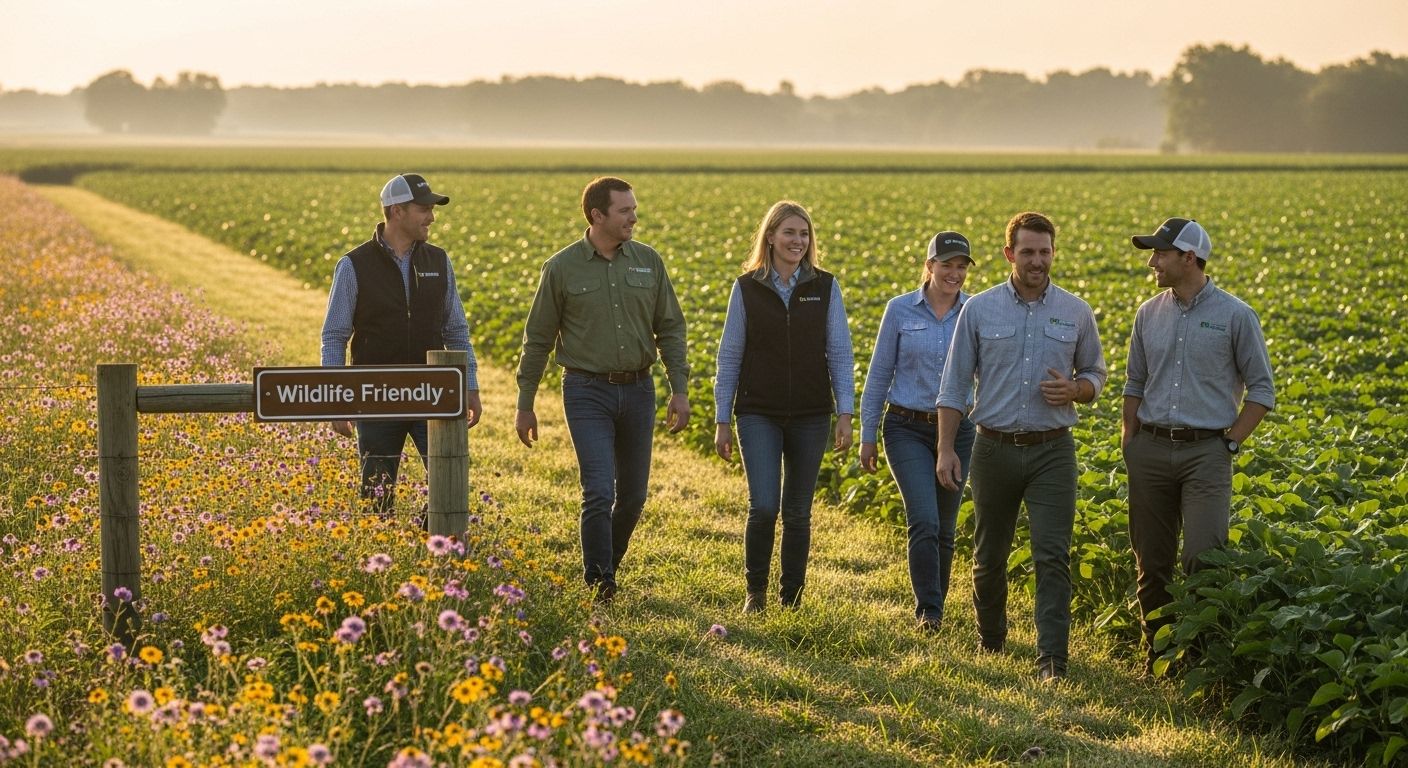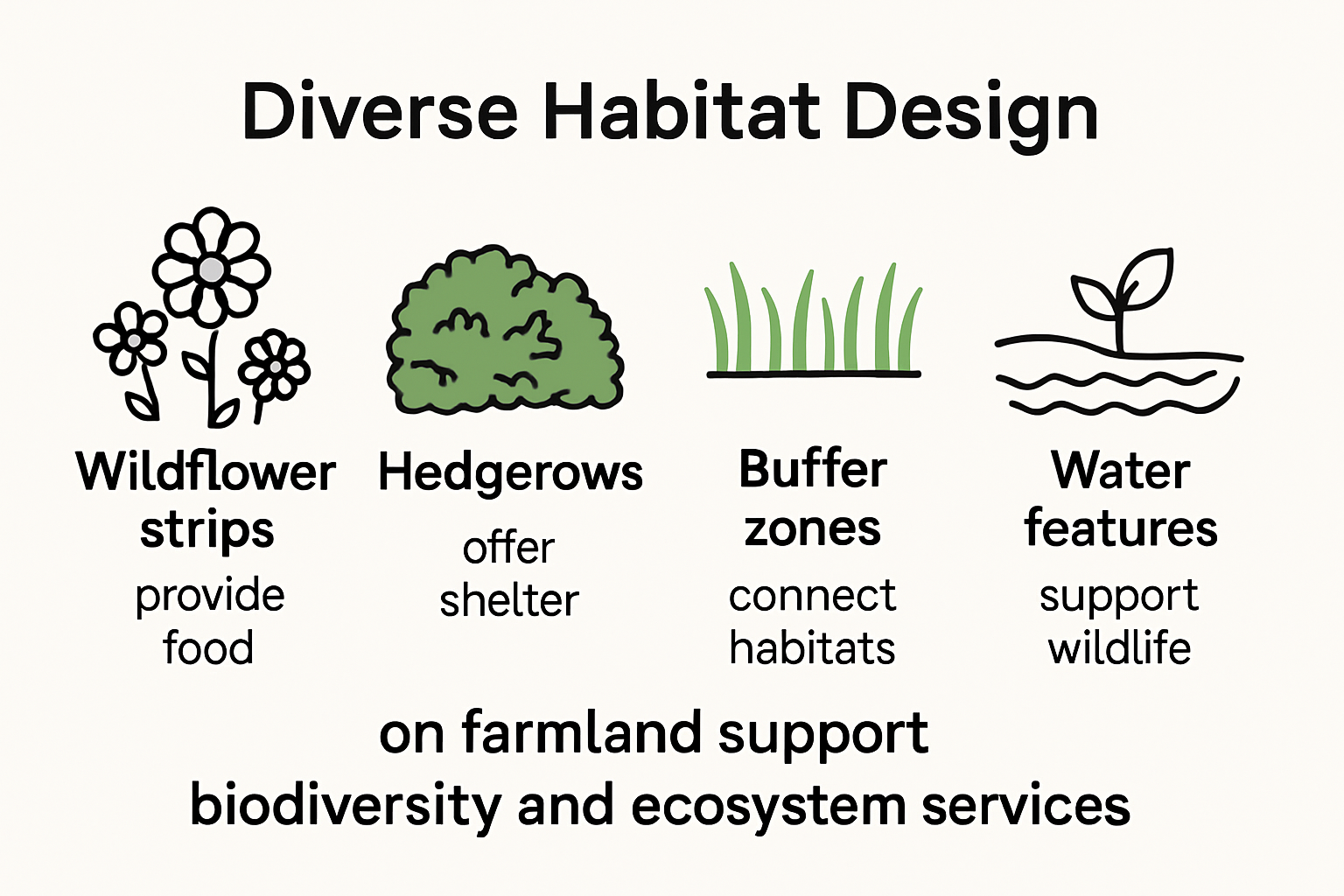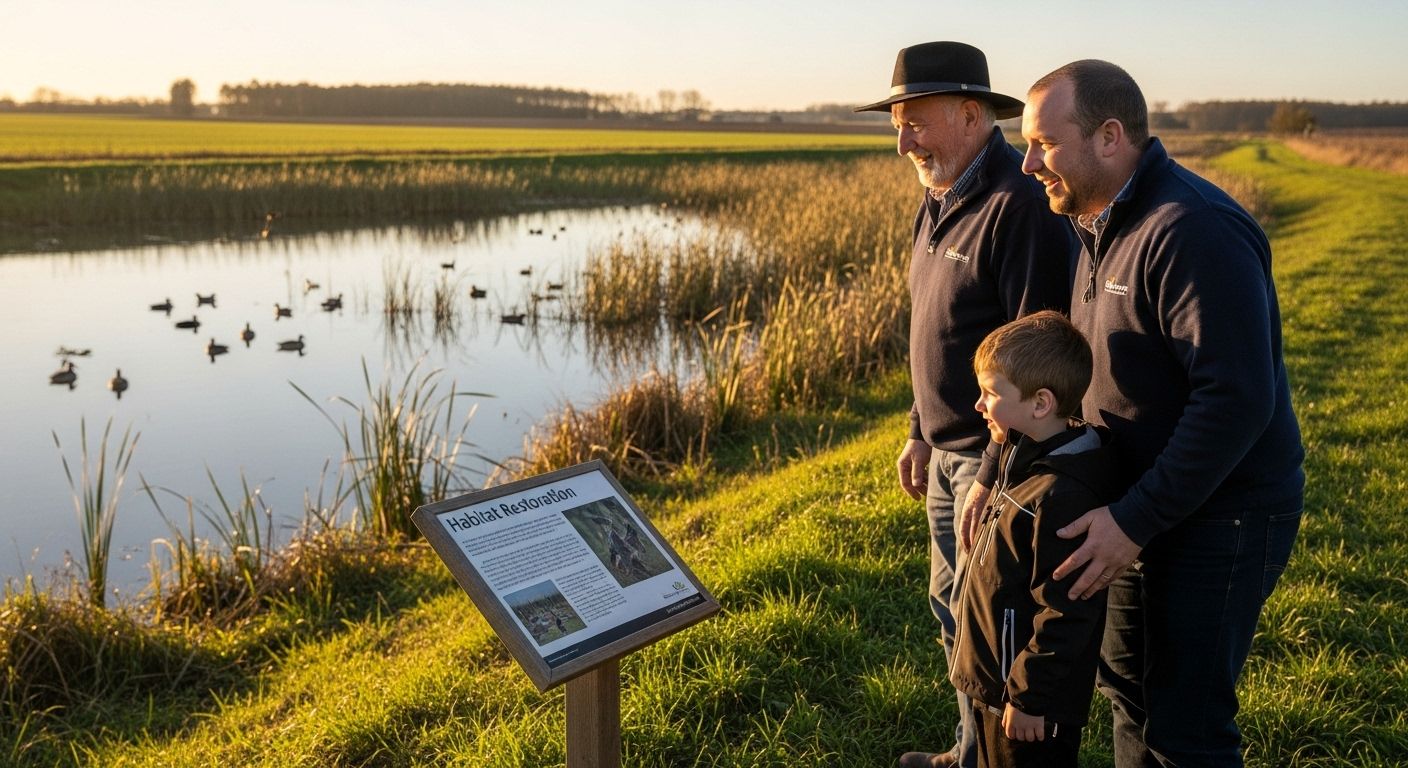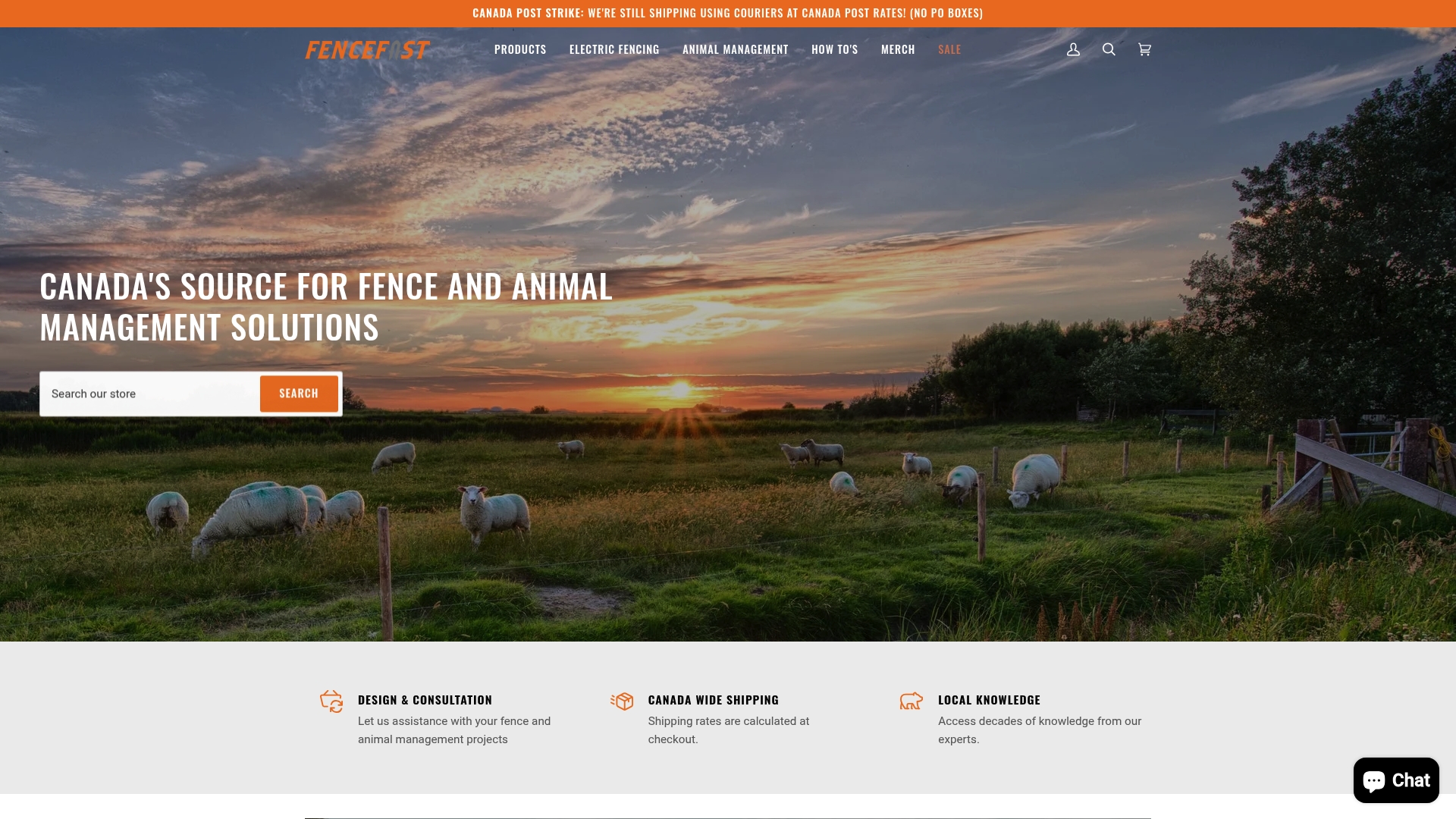
Wildlife friendly farming is getting a lot of attention for one simple reason, it has a real impact on crop yields and the health of the land. Imagine transforming just 3% to 8% of your field edges and seeing higher yields that actually beat traditional farming expectations. Most people assume giving up land for wildlife means you lose money. Turns out, those wildlife corridors might be the best investment a farmer can make in 2025.
Table of Contents
- How Wildlife Friendly Farming Supports Yields
- Best Practices For Creating Wildlife Habitats
- Tools, Equipment, And Technology For Wildlife Friendly Farms
- Real World Examples And Success Stories
Quick Summary
| Takeaway | Explanation |
|---|---|
| Integrate wildlife for better crop yields | Wildlife friendly farming enhances biodiversity, leading to improved pollination and higher crop yields through strategic habitat management. |
| Utilize natural pest control | Establish habitats for predatory species to minimize pesticide use and maintain ecological balance, effectively managing pest populations. |
| Design diverse habitats strategically | Create varied vegetation layers and native plantings to foster wildlife habitats that support local biodiversity while maintaining agricultural productivity. |
| Adopt modern technology for wildlife monitoring | Use advanced tools like drones and sensors to gather data on wildlife movements and habitat conditions, informing adaptive management practices. |
| Learn from real-world success stories | Examine successful examples of wildlife friendly farms for practical insights, demonstrating that sustainable agriculture is achievable and beneficial. |
How Wildlife Friendly Farming Supports Yields
Wildlife friendly farming represents a strategic approach that transforms agricultural landscapes into productive ecosystems where crop production and biodiversity coexist harmoniously. Contrary to traditional farming methods that view wildlife as competitors, modern agricultural science reveals that integrating wildlife support can actually enhance farm productivity and resilience.
Pollinator Partnerships and Crop Production
Pollinators play a critical role in agricultural success, and wildlife friendly farming creates environments that support these essential creatures. Research from the Sustainable Agriculture Research and Education program demonstrates that enhancing biodiversity through strategic habitat management can significantly improve crop yields. By planting diverse flowering species and maintaining natural corridors, farmers can attract beneficial insects like bees, butterflies, and other pollinators that directly contribute to crop reproduction.
A groundbreaking six-year study conducted on a 900-hectare commercial arable farm in central England provided compelling evidence of this approach. The study revealed that converting just 3% to 8% of field edges into wildlife habitats resulted in increased crop yields in the remaining cultivated areas. This discovery challenges the conventional belief that dedicating land to wildlife reduces agricultural productivity.
To clarify the key outcomes of the referenced UK study and demonstrate the effects of allocating field edges to wildlife habitats, the following table summarizes the main findings:
| Field Edge Allocation (%) | Impact on Remaining Crop Yields | Conventional Assumption |
|---|---|---|
| 0 (Traditional approach) | Baseline yield | No land given to wildlife – maximum crop area |
| 3 | Yield increases observed in cultivated area | Yield would decrease as some land removed |
| 8 | Yield increases observed in cultivated area | Yield would decrease further |
Natural Pest Control and Ecosystem Balance
Wildlife friendly farming goes beyond pollination by establishing natural pest control mechanisms. By creating habitats that support predatory insects and birds, farmers can reduce their reliance on chemical pesticides. Research indicates that implementing wildlife-friendly strategies leads to increased populations of beneficial species that naturally manage pest populations.
These natural predators help maintain ecological balance, reducing crop damage and minimizing the need for extensive chemical interventions. Predatory insects like ladybugs, lacewings, and ground beetles can consume significant quantities of agricultural pests, providing a sustainable alternative to traditional pest management approaches.
Long-Term Agricultural Resilience
By supporting wildlife, farmers build more robust and adaptable agricultural systems. Diverse ecosystems are inherently more resilient to environmental changes, climate fluctuations, and potential disease outbreaks. Wildlife friendly farming creates a buffer against agricultural vulnerabilities by promoting biodiversity and maintaining complex ecological interactions.
Implementing these practices requires thoughtful planning and a holistic understanding of local ecosystems. Farmers must consider native species, landscape characteristics, and seasonal variations when designing wildlife-supportive agricultural strategies. The investment in creating these supportive environments pays dividends through improved soil health, enhanced pollination services, and more stable crop production.
Ultimately, wildlife friendly farming represents more than an ecological philosophy—it is a pragmatic approach to sustainable agriculture that recognizes the intricate connections between farming practices and broader ecosystem health. By viewing wildlife as collaborators rather than competitors, farmers can unlock new potentials for productivity and environmental stewardship.
Best Practices for Creating Wildlife Habitats
Creating effective wildlife habitats on agricultural land requires strategic planning and a comprehensive understanding of local ecosystems. Successful wildlife-friendly farming goes beyond simply leaving areas undisturbed and involves intentional design that supports diverse species while maintaining agricultural productivity.
To help farmers plan and implement best practices, the table below summarizes key habitat creation strategies, their benefits, and examples as discussed in this section:
| Practice | Benefits | Examples |
|---|---|---|
| Native Plant Selection | Supports local wildlife, lower maintenance | Wildflower strips, hedgerows |
| Diverse Vegetation Layers | Provides food/shelter for multiple species | Ground cover, shrubs, trees |
| Habitat Corridors | Enables wildlife movement and genetic diversity | Buffer zones, connected plantings |
| Water Feature Installation | Attracts birds, insects, small mammals | Ponds, bird baths, drainage areas |
| Shelter Provision | Offers breeding and protective habitats | Nesting boxes, rock piles |
| Seasonal/Adaptive Management | Enhances effectiveness through ongoing observation | Grazing rotation, controlled burns |
Strategic Habitat Design and Native Plantings
The foundation of wildlife habitat creation begins with understanding local biodiversity and selecting appropriate native plant species. Research from the National Wildlife Federation emphasizes the importance of using indigenous plants that provide food, shelter, and breeding grounds for local wildlife. Native plants are adapted to local climate conditions and require less maintenance, making them ideal for agricultural landscapes.
Farmers should focus on creating diverse vegetation layers that include ground cover, shrubs, and trees. These multilayered habitats support different wildlife species by providing varied microenvironments. Strategic plantings can include native wildflower strips, hedgerows, and buffer zones that connect existing natural areas. Conservation experts from the Xerces Society recommend designing habitat corridors that allow wildlife movement and genetic exchange between different ecosystem patches.

Water and Shelter Management
Water sources are critical components of wildlife habitats. Implementing small-scale water features like shallow ponds, bird baths, or drainage areas with native vegetation can attract and support diverse wildlife populations. These water sources should be designed to minimize mosquito breeding while providing drinking and bathing opportunities for birds, insects, and small mammals.
Shelter creation is equally important in wildlife-friendly farming. This involves maintaining dead trees, creating rock piles, installing nesting boxes, and preserving fallen logs that provide habitat for insects, small mammals, and birds. These structures offer protection from predators and harsh weather conditions while supporting complex ecological interactions.
Seasonal Considerations and Adaptive Management
Wildlife habitat management requires an adaptive approach that considers seasonal changes and local ecosystem dynamics. Farmers should develop management plans that account for breeding seasons, migration patterns, and the specific needs of different wildlife species in their region. This might involve rotating grazing areas, implementing controlled burning techniques, or adjusting crop cultivation practices to minimize disruption.
Monitoring and documenting wildlife presence can help farmers refine their habitat creation strategies. Using trail cameras, conducting periodic wildlife surveys, and collaborating with local conservation organizations can provide valuable insights into the effectiveness of habitat management techniques.
Implementing wildlife-friendly practices is not a one-size-fits-all approach. Each farm represents a unique ecosystem with specific challenges and opportunities. Successful habitat creation requires patience, observation, and a willingness to experiment and adapt management strategies based on local conditions and wildlife responses.
By integrating wildlife habitat considerations into agricultural landscapes, farmers can transform their lands into productive ecosystems that support biodiversity while maintaining agricultural output. This holistic approach recognizes that healthy ecosystems are interconnected and that supporting wildlife is not just an environmental goal but a strategic agricultural practice.
Tools, Equipment, and Technology for Wildlife Friendly Farms
Modern wildlife friendly farming demands a sophisticated approach that integrates advanced technologies with ecological conservation strategies. Farmers now have access to innovative tools and equipment that support both agricultural productivity and wildlife habitat preservation.
Precision Monitoring and Wildlife Management Technologies
Technological advancements are revolutionizing wildlife friendly farming practices. The USDA’s conservation guidelines highlight emerging technologies that enable farmers to monitor and protect wildlife while maintaining agricultural productivity. Unmanned aerial vehicles (UAVs) have become particularly valuable for comprehensive landscape monitoring, allowing farmers to track wildlife movements, assess habitat conditions, and implement targeted conservation strategies.
One groundbreaking development is the Geofenced Unmanned Aerial Robotic Defender (GUARD), an integrated UAV system designed for autonomous wildlife deterrence. This technology combines computer vision with real-time monitoring, enabling farmers to manage wildlife interactions without causing harm. Such systems can detect animal movements, create protective zones, and provide critical data about wildlife interactions within agricultural landscapes.
Sustainable Equipment and Conservation Tools
Wildlife friendly farming requires specialized equipment that minimizes environmental disruption. The National Wildlife Federation’s Future Friendly Farming report emphasizes the importance of conservation-oriented tools like precision irrigation systems, low-impact tillage equipment, and habitat management tools. These technologies help farmers create more nuanced and wildlife-supportive agricultural environments.
Implementing tools like electric fence management systems can help farmers create protective boundaries that prevent wildlife from entering sensitive crop areas while maintaining safe migration corridors. Such equipment allows for strategic habitat management, reducing potential conflicts between agricultural activities and local wildlife populations.
Data-Driven Conservation Strategies
Advanced sensors and monitoring equipment now enable farmers to collect detailed ecological data. These tools can track soil health, vegetation growth, wildlife populations, and microclimate conditions. By integrating data collection technologies, farmers can develop more precise and adaptive wildlife friendly farming strategies.
Sophisticated tracking devices, wildlife cameras, and environmental sensors provide real-time insights into ecosystem dynamics. These technologies allow farmers to understand wildlife behavior patterns, migration routes, and habitat utilization. The collected data helps in creating more targeted conservation efforts that balance agricultural productivity with wildlife preservation.
Embracing these technological innovations requires ongoing education and a willingness to experiment. Farmers must continuously update their knowledge and adapt their approaches as new tools and research emerge. The future of wildlife friendly farming lies in seamlessly integrating cutting-edge technology with ecological understanding.
By investing in advanced monitoring tools, precision equipment, and data-driven technologies, farmers can transform their agricultural landscapes into dynamic ecosystems that support both food production and wildlife conservation. This approach represents a forward-thinking strategy that recognizes the interconnectedness of agricultural productivity and environmental stewardship.
Real World Examples and Success Stories
Real-world success stories demonstrate the tangible benefits of wildlife friendly farming, providing inspiring examples of how agricultural practices can simultaneously support ecological conservation and productive farming operations. These narratives showcase innovative approaches that transform traditional agricultural landscapes into thriving ecosystems.
To provide a clear comparison of the real-world examples highlighted in this section, the table below summarizes each project’s location, main practice implemented, and the key outcomes achieved:
| Location (State/County) | Main Practice/Innovation | Key Outcomes |
|---|---|---|
| Harrison County, Iowa | 40 acres converted to wildlife sanctuary | Supports wildlife, personal recovery |
| Winnebago County, Iowa | Tech tools (yield monitors, drones); cover crops | Resource conservation, steady yields |
| Starke County, Indiana | 200 acres restored to wetland/wildlife | High biodiversity, thriving wetland |
| Wythe County, Virginia | Buffer areas, fencing, water systems | Better livestock & wildlife habitat |
| San Joaquin Valley, California | Collaborative strip-tillage for dairy | Sustainability, economic viability |
Transformative Conservation Initiatives
The USDA’s Natural Resources Conservation Service highlights remarkable success stories that illustrate the potential of wildlife-friendly farming. In Harrison County, Iowa, a landowner converted 40 acres into a sanctuary that not only supports local wildlife but also provides a personal space for recovery and connection with nature. This project exemplifies how strategic land management can create multifunctional agricultural spaces that benefit both wildlife and human communities.
Another compelling example comes from Winnebago County, where a farmer leveraged advanced technologies like yield monitors and drones to implement cover crop strategies. By integrating these technological tools with ecological considerations, the farmer successfully addressed natural resource concerns while maintaining crop productivity. Such approaches demonstrate that wildlife-friendly farming is not about sacrificing agricultural output but about creating more intelligent, sustainable farming systems.
Habitat Restoration and Ecosystem Transformation
The USDA’s Farm Service Agency showcases remarkable habitat restoration projects that highlight the potential of wildlife-friendly farming. In Starke County, Indiana, Mark and Amy Magura transformed over 200 acres of former farmland into a vibrant wetland and wildlife sanctuary. This remarkable project has created a flourishing habitat supporting diverse species of birds, frogs, and other wildlife.

Similarly, in Wythe County, Virginia, Bill Cooper implemented a strategic conservation approach by converting eight acres of his farm into critical buffer areas. By installing specialized fencing and water systems, Cooper improved both livestock management and wildlife habitat. These examples demonstrate how targeted interventions can create significant ecological benefits without compromising agricultural productivity.
Sustainable Agriculture and Ecosystem Collaboration
The U.S. Environmental Protection Agency presents innovative agricultural success stories that emphasize collaborative and sustainable practices. The Giacomazzi Dairy in the San Francisco Bay Delta serves as a prime example of holistic agricultural management. By collaborating with the USDA-NRCS and the University of California, the dairy implemented a groundbreaking strip-tillage corn planting system in the Central San Joaquin Valley.
This project represents a comprehensive approach to wildlife-friendly farming, where economic viability and environmental conservation are viewed as complementary rather than competing objectives. By continuously seeking sustainable practices and embracing technological innovations, agricultural operations can create ecosystems that support biodiversity while maintaining productive farming systems.
These success stories underscore a critical message: wildlife-friendly farming is not a theoretical concept but a practical, achievable approach to agricultural management. They demonstrate that with creativity, technological innovation, and a commitment to ecological principles, farmers can transform their lands into dynamic, productive ecosystems that support both agricultural output and wildlife conservation.
By learning from these real-world examples, farmers and landowners can gain inspiration and practical insights into implementing wildlife-friendly practices. These stories prove that sustainable agriculture is not just possible but can be a rewarding and economically viable approach to land management.
Frequently Asked Questions
What is wildlife friendly farming?
Wildlife friendly farming is an agricultural approach that integrates habitats for wildlife into farming practices. This method promotes biodiversity, enhances crop yields, and supports ecosystem health by creating environments conducive to beneficial species like pollinators and natural pest controllers.
How can wildlife friendly farming increase crop yields?
Integrating wildlife into farming can enhance pollination and establish natural pest control mechanisms. Studies have shown that dedicating just 3% to 8% of field edges to wildlife habitats can lead to higher crop yields compared to traditional farming methods by promoting a balanced ecosystem.
What are some best practices for creating wildlife habitats on farms?
Best practices include selecting native plants, creating diverse vegetation layers, establishing wildlife corridors, installing water features, and providing shelter. These strategies support local wildlife while maintaining agricultural productivity and promote ecological balance.
How can technology aid wildlife friendly farming?
Modern technology, such as drones and precision monitoring systems, can assist in wildlife management by tracking animal movements, assessing habitat conditions, and informing adaptive management strategies. These tools help integrate ecological considerations while improving agricultural efficiency.
Make Your Farm Wildlife-Friendly Without Sacrificing Productivity
If you want to boost yields and protect local wildlife as described in “Wildlife Friendly Farming Tips for Landowners in 2025,” the right fencing and animal management tools are critical. Farmers often worry that dedicating field edges or buffer zones to wildlife habitats means more pests, less crop area, and complicated livestock control. But solutions exist for these exact challenges. Products such as electric fencing systems and smart animal monitoring can help you maintain clear wildlife corridors while safeguarding crops and livestock. With effective boundaries and tools, you can enjoy improved pollination, natural pest control, and long-term land health—without giving up control or productivity.

Take the next step toward building a resilient, sustainable farm that works with nature. Explore how FenceFast.ca can help you set up field-edge fencing, install electric deterrents, or optimize animal monitoring. Shop now to see the difference modern fencing systems and livestock tools can make. Your land can thrive while you support wildlife, so start planning your wildlife-friendly setup today at FenceFast.ca.
Recommended
-
[
Gallagher S200 Portable Solar Fence Energizer 2.0 joules – FenceFast Ltd.
](https://fencefast.ca/products/gallagher-solar-fence-energizer-s200)
-
[
Gallagher KIWITAH 3 X Grounding Kit for Large Energizer – FenceFast Ltd.
](https://fencefast.ca/products/gallagher-kiwitah-ground-stake-kit)
-
[
Plastic Drum with Lid - 15 Gallon, Open Top, Blue – FenceFast Ltd.
](https://fencefast.ca/products/plastic-drum-with-lid-15-gallon-open-top-blue)
-
[
Lamb Packer – FenceFast Ltd.
